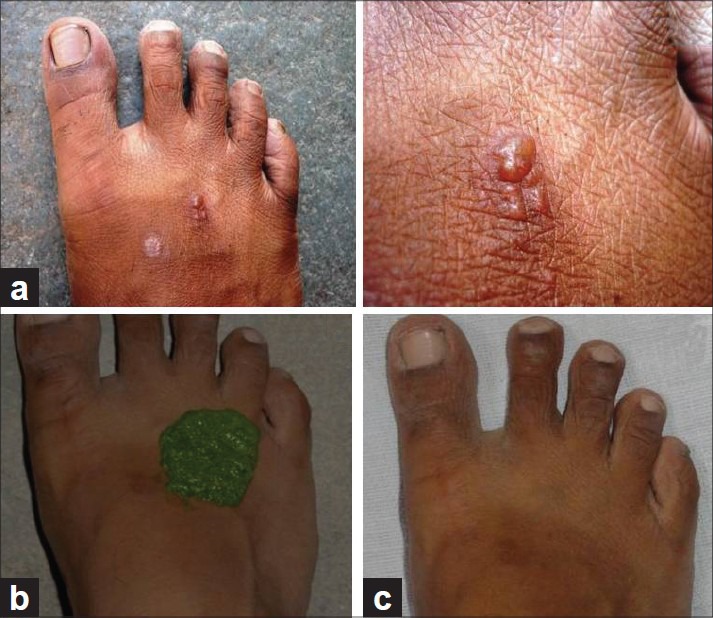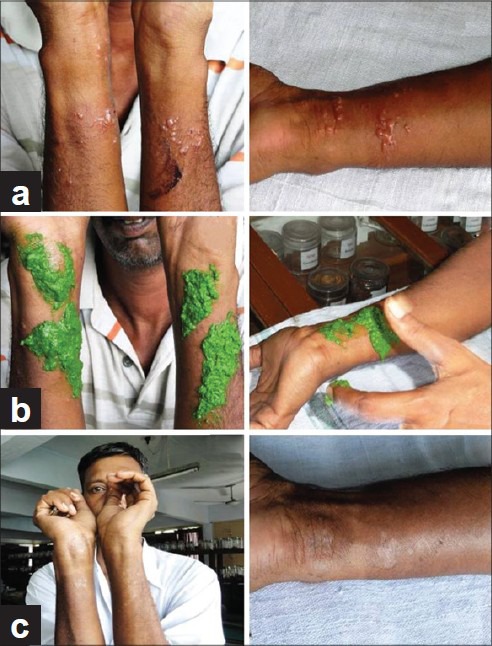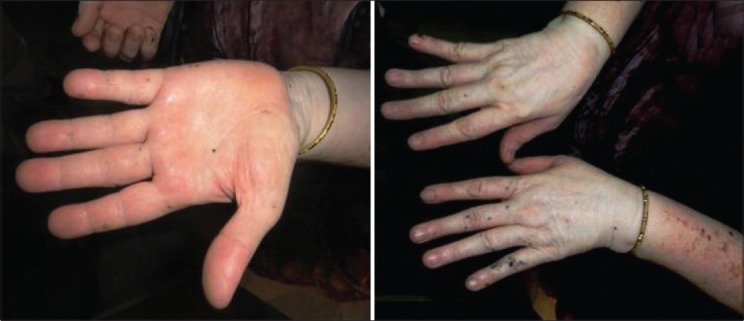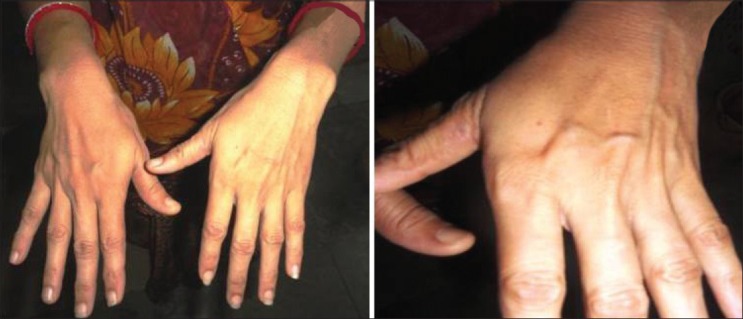Abstract
Bhallataka (Semecarpus anacardium Linn.; Ancardiaceae) is mentioned under Upavisha group in Ayurvedic classics and it is described as a poisonous medicinal plant in Drugs and Cosmetics Act (India), 1940. Fruit of Bhallataka is used either as a single drug or as an ingredient in many compound formulations of Indian systems of medicine to cure many diseases. Tarry oil present in the pericarp of the fruit causes blisters on contact. The major constituent of the tarry oil is anacardic acid and bhilawanol, a mixture of 3-n-pentadec(en)yl catechols. Bhilawanol A and B are known as Urushiols, and also, anacardic acid is closely related to Urushiol. Urushiol-induced contact dermatitis is the medical name given to allergic rashes produced by the oil Urushiol. This paper deals with five case reports of contact dermatitis caused during different stages of Shodhana (purificatory measures) of Bhallataka fruit due to improper handling of the utensils and disposal of media used in Shodhana procedure and their Ayurvedic management. To combat these clinical conditions, the affected persons were advised external application with pounded Nimba (Azadirachta indica A. Juss.) leaves on the affected parts and internal administration of Sarivadyasava 30 ml thrice daily after food and Triphala Churna 5 g before food twice daily. Reduction of itching and burning sensation was observed after topical application.
Keywords: Bhallataka, bhilawanol, blisters, dermatitis, Semecarpus anacardium Linn., urushiol
Introduction
The fruit of Bhallataka (Semecarpus anacardium Linn.; Anacardiaceae) is a potent drug having high priority and applicability in indigenous systems of medicine and is being indicated for many ailments. It is administered internally in cases of Nadi Dourbalya (nervous debility), Amavata (rheumatism), Apasmara (epilepsy), Gridhrasi (sciatica), Shvasa (asthma),[1] etc. Many compound formulations like Brihatbhallataka Avaleha, Bhallatakadi Churna, Bhallataka Kshara,[2] Bhallatakadi Kwatha, Bhallataka Ghrita,[3] etc. contain Bhallataka as an ingredient. Bhallataka is mentioned under Upavisha group in Ayurvedic classics,[4] as a poisonous medicinal plant in Drugs and Cosmetics Act (India), 1940[5] and should be administered internally only after Shodhana (purificatory measures).[6] Sophahetu, the synonym attributed to Bhallataka due to its blister causing nature,[7] indicates that this drug has to be handled with proper precautionary methods during collection, processing, etc. During collection and processing, coconut oil should be applied on face and exposing parts of the body to avoid possibility of irritation and blister formation.[8]
Semecarpus ancardium fruits are attached with receptacle, where receptacle is considered as false fruit. The color of the false fruit is green in unripe stage and turns yellowish orange on ripening. Pericarp is considered as fruit, and it is drupaceous, laterally flattened, obliquely ovoid, of 2.5–3 cm in length, and is green in unripe and turns blackish brown when ripe. The nature of the fruit is smooth and shining with residual receptacle. Cotyledon is white in color and is 1–1.5 cm long. Microscopic studies revealed the presence of large amount of oils in the pericarp on treatment with Sudan III.[9] Tarry oil present in the pericarp of the fruit causes blisters on contact. The corrosive juice from the pericarp of the fruit is found to contain catechol, fixed oil, and anacardol (C18H13O3.COOH) and the corrosive properties of the juice are due to two phenolic acids C16H15O3.COOH and C14H13O3.COOH.[10] Major chemical constituents of tarry oil are bhilawanol, a mixture of phenolic compounds, including cis and trans isomers of urushiol (3-pentadecenyl-8′catechol).[11] Two incompletely identified phenols, perhaps analogous to the cardanol of Cashew Nut Shell Liquid (CNSL), being decarboxylated anacardic acids are also reported. Among these, one is being named as semecarpol and appears to be an undecenyl phenol[12] and the other, named as anacardol, appears to be a dodecenyl phenol.[10]
When the tarry oil comes in contact with skin, it produces dermatitis.[13] Medically it is named as urushiol-induced contact dermatitis. The American Academy of Dermatology estimates that there are up to 50 million cases of urushiol-induced dermatitis annually in the United States alone, accounting for 10% of all lost-time injuries in the United States Forest Service.[14]
The symptoms include itching, redness, burning sensation, swelling, papules, vesicles, blisters, and streaking. Sometimes it may result in an allergic eczematous contact dermatitis. The rash takes 1–2 weeks to run its course and normally does not leave scars. Severe cases have small (1–2 mm) clear fluid-filled blisters on the skin. Pus-filled vesicles, containing a whitish fluid, may indicate a secondary infection. Excessive scratching may result in secondary infection, commonly by staphylococcal and streptococcal species.[13]
Primary treatment involves washing the exposed skin thoroughly with soap and water as soon as possible after exposure is discovered. Soap or detergent is necessary, as urushiol is a hydrophobic (not water soluble) oil. Scrubbing with plain soap and cold water will remove the urushiol from skin, if it is done within a few minutes of exposure, before it bonds.[13] Ice, cold water, or cold air does not help to cure rashes, but cooling can reduce inflammation and soothe the itch.[15] To reduce the severity of rashes and blisters, internal and external medication should be done.[16] Ayurvedic system of medicine advised to take the Pitta Shamaka treatments both externally and internally.[17] Bhallataka-induced dermatitis has been reported,[18] but dermatitis caused during collection, storage, and during different stages of Shodhana process is not reported. Hence, an attempt has been made to report five cases of urushiol-induced dermatitis from Bhallataka fruit, during different stages of Shodhana, and their clinical management through Ayurveda.
Case Report
Shodhana of Bhallataka was carried out in the Department of Dravyaguna, I.P.G.T. and R.A., Gujarat Ayurved University. Five research workers and laboratory assistants, who came in contact with the fruits at work place during storage, processing (Shodhana), cleaning the instruments and equipments, and disposing the media (cow’s urine, cow’s milk, tender coconut water, etc.) used for Bhallataka Shodhana reported contact dermatitis. They were treated in the O.P.D., Department of Dravyaguna, IPGT & RA, Jamnagar.
A male of 33 years (Case 1) presented with blisters and itching caused after Bhallataka collection and drying process. Accidentally the contact of oil on leg from the ruptured nut caused itching in the beginning with slight burning sensation. After 10 h of the contact, blisters occurred in the leg [Figure 1].
Figure 1.

Urushiol induced contact dermatitis caused by Bhallataka fruits in case 1; a) Bhallataka blisters, b) Application of Neem paste, c) After treatment
Four cases were reported while processing the Bhallataka nuts. A male research worker of 40 years (Case 2) who used to assist in cleaning the instruments and equipments used for processing the Bhallataka reported with itching, burning sensation, and redness of the skin. After 11 h of contact, severe blisters occurred [Figure 2]. Two female research workers of 55 years [Case 3, Figure 3] and a 43 years [Case 4, Figure 4] who disposed the media used for Shodhana reported with itching, redness, and burning sensation on both hands. Blisters were not reported in Case 3 and 4. Another case, a male of 33 years (Case 5), reported with itching all over the body and black patches on the face because of the fumes coming out during Svedana (boiling) of Bhallataka, a traditional method of processing the Bhallataka fruits.[6]
Figure 2.

Urushiol induced contact dermatitis caused by Bhallataka fruits in case 2; a) Bhallatakablisters, b) Application of Neem paste, c) After treatment
Figure 3.

Urushiol induced contact dermatitis caused by Bhallataka fruits in case 3
Figure 4.

Urushiol induced contact dermatitis caused by Bhallataka fruits in case 4
Management and Observations
Along with internal and external medication, [Table 1] the subjects were advised to take tender coconut water twice daily. In Case 1, blisters subsided within 2 days and it took 5 days for the blisters to subside in Case 2, but the external medication was continued for 7 days. The severity of blisters and area of blister formation was more in Case 2 [Figure 2]. In Case 3 and 4, there was no blister formation; only itching with reddish discoloration was observed, so only external application of coconut oil was advised. Within 3 days, the symptoms subsided, but application of coconut oil was done for 7 days. For Case 5, treatment was continued for 15 days internally and 7 days externally to reduce the black patches on face and to get the normal glow on the face.
Table 1.
Treatment schedule

Discussion
The Bhallataka Nut Shell Liquid (BNSL) present in the pericarp of the fruit contains tarry oil consisting of anacardic acid 90% and cardol 10%. Other isolated chemical constituents are bhilawanols (urushiols). These are the chemical constituents responsible for the irritation and toxicity.[19, 20]
In Ayurveda, it is clearly mentioned that the drug Bhallataka should be used after Shodhana (purification/processing).[6] Shodhana plays an important role to reduce the adverse effects during internal administration. Bhallataka should be collected and processed with due consideration of precautionary methods mentioned in Ayurvedic classics. Applying the coconut oil on exposed body parts and drinking tender coconut water will reduce the irritation. Hence, one should apply coconut oil on face, hands and legs during the collection, drying, and Shodhana process.[8] If dermatitis occurs, Pitta Shamaka Dravyas (drugs that alleviate Pitta) are advised internally and externally.[17, 20] Vibhitaki (Terminalia bellerica),[20] albumin of coconut, Tila (Sesamum indicum), and Haritaki (Terminalia chebula)[21] are used as antidotes internally, and coconut oil[8] and ghee[22] are used externally. Nimba Patra Kalka (neem leaf paste) can be used externally because of its Pitta Shamaka property and it is indicated for Vrana (wound), Krimi (worms), Kushtha (skin diseases), and Visha (poison) in Ayurvedic classics.[23] Recent researches have proved its antibacterial[24] and wound healing activity.[25] Panchavalkala Kwatha (bark decoction of five Ficus species) is indicated for cleaning the wounds,[26] so can be used externally in the condition of Bhallataka blisters.
In the cases presented here, Neem leaf paste was used for Lepa (topical application) [Figures 1 and 2]. After 1 h, the paste was washed with Panchavalkala Kwatha and Seka (pouring continuously) with the same decoction (Panchavalkala Kwatha) for 30 min was done. This treatment was continued for 7 days. It showed good and quick results in subsiding the blisters. Internally Sarivadyasava for 15 days and Triphala Churna for 7 days helped in curing the blisters rapidly.
Conclusion
Precautionary methods must be followed right from collection of the drug Bhallataka (fruits) and disposal of media and handling of utensils used in Shodhana process. Applying coconut oil before collection and during processing will protect from developing contact dermatitis caused by Bhallataka fruits. Pitta Shamaka measures to be followed to subside the urushiol-induced contact dermatitis. The Shodhana (processing) of Bhallataka should be conducted in an open place.
References
- 1.Sharma PV. Dravyaguna vijnana. vol. 2. Varanasi: Chaukhambha Bharti Academy; 1999. pp. 168–9. [Google Scholar]
- 2.Madham Shetty, Suresh Babu. Yogaratnakara. 1st ed. Varanasi: Chaukhambha Sanskrit Series Office; 2005. p. 345, 354, 374. [Google Scholar]
- 3.Govind Das. Bhaishajyaratnavali. 2001. [Google Scholar]; Ambikadatta Sastry., editor. Varanasi: Chaukhambha Sanskruta Samsthan; pp. 610pp. 685–6. [Google Scholar]
- 4.Sadananda Sharma. Rasa Tarangini. 11th ed 2004. [Google Scholar]; Kasinath sastri., editor. New Delhi: Motilal Banarasidas; pp. 648–9. [Google Scholar]
- 5.Malik V. Drugs and Cosmetics act 1940 with Drugs and Cosmetics rules. 18th ed. Lucknow: Eastern Book Company; 2005. p. 282. [Google Scholar]
- 6.Sadananda Sharma. Rasa Tarangini. 11th ed 2004. [Google Scholar]; Kasinath Shastri. New Delhi: Motilal Banarasidas; pp. 478–9. [Google Scholar]
- 7.Bapalal G. Vaidya. Nighantu Adarsha. 1st ed. vol. 1. Varanasi: Chaukhamba Bharati Academy; 2007. p. 315. [Google Scholar]
- 8.Chunekar KC, Pandey GS. Bhavaprakasha Nighantu. 10th ed. Varanasi: Chaukhamba Bharati Academy; 1999. pp. 139–41. [Google Scholar]
- 9.Ilanchezhian R, Roshy Joseph C, Acharya RN, Harisha CR, Shukla VJ. Pharmacognostical and Physicochemical Analysis of Bhallataka (Semecarpus anacardium Linn.) – Fruit. Phcog J. 2011;3:9–16. [Google Scholar]
- 10.Naidu DS. Constituents of the marking-nut: Semecarpus anacardium Linn. J Indian Inst Sci. 1925;8:129–42. [Google Scholar]
- 11.Nagabhushanaa KS, Umamaheshwari S, Tocolic FE, Prabhu SK, Green IR, Ramadoss CS. Inhibition of soybean and potato Lipoxygenases by Bhilawanols from Bhilawan (Semecarpus anacardium) nut shell liquid and some synthetic Salicylic acid analogues. J Enzyme Inhib Med Chem. 2002;17:255–9. doi: 10.1080/1475636021000006243. [DOI] [PubMed] [Google Scholar]
- 12.Pillay P, Siddiqui S. Chemical examination of the marking-nut (Semecarpus anacardium Linn) J Indian Chem Soc. 1931;8:517–25. [Google Scholar]
- 13. [Accessed on 2011 Jun 15]. Available from: http://en.wikipedia.org/wiki/Urushiol-induced_contact_dermatitis .
- 14.Armstrong WP, Epstein WL. Poison Oak: More Than Just Scratching The Surface. Herbalgram (American Botanical Council) 1995;34:36–42. Available from: http://waynesword.palomar.edu/ww0802.htm . [Google Scholar]
- 15.Poison Ivy. Prevention and Treatment? [Last Accessed on Dec 03]. Available from: http://www.intelihealth.com/IH/ihtIH/WSIHW000/7945/8214/7770.html?d=dmtJHE%20 .
- 16.Gyanendra Pandey. Dravyaguna Vijnana, Part 1. 3rd ed. Varanasi: Chaukhambha Krishnadas Academy; 2005. pp. 343–55. [Google Scholar]
- 17.Nirmal Saxena. Vangasena Samhita. 1st ed. vol. 2. Varanasi: Chaukhambha Sanskrit Series Office; 2004. p. 483. [Google Scholar]
- 18.Norman R, Goldsmith MD. Dermatitis from Semecarpus anacardium (Bhilawanol or the marking nut) JAMA. 1943;123:27. [Google Scholar]
- 19.Mukheri B. The Wealth of Indian Alchemy and its Medicinal Uses. 2nd ed. vol. 1. New Delhi: Sri Satguru Publication; 1998. p. 388. [Google Scholar]
- 20.Agnives CR, Unnikrishnan P, George MJ, editors. Toxicology – Ayurvedic perspective. 1st ed. Kottakkal: Department of Agadatantra, Vaidyarathnam PS Varier Ayurveda College; 2002. pp. 201–2. [Google Scholar]
- 21.Nadkarni KM. Indian Materia Medica. 3rd ed. vol. 1. Mumbai: Popular Prakashan Pvt. Ltd; 2007. pp. 1119–25. [Google Scholar]
- 22.Ashwini Kumar A Raut, Sawant NS, Badre AS, Amonkar AJ, Vaidya AD. Bhallatak (Semecarpus anacardium Linn.) – A Review. Indian J Tradit Knowl. 2007;6((4)):653–59. [Google Scholar]
- 23.Chunekar KC, Pandey GS. Bhavaprakasha Nighantu. 10th ed. Varanasi: Chaukhamba Bharati Academy; 2006. pp. 329–31. [Google Scholar]
- 24.Koona S, Budida S. Antibacterial Potential of the Extracts of the Leaves of Azadirachta indica Linn. Not Sci Biol. 2011;3:65–9. [Google Scholar]
- 25.Thakare VM, Chaudhari RY, Patil VR. Promotion of cutaneous wound healing by herbal formulation containing Azadirachta indica and Cynodon dactilon extract in wistar rats. International Journal of Pharmaceutical Research & Development. 2011;3:80–6. [Google Scholar]
- 26.Hegde P, Hemanth DT, Emmi SV, Shilpa MP, Shindhe PS, Santosh YM. A case discussion on eczema. Int J Ayurveda Res. 2010;1:268–70. doi: 10.4103/0974-7788.76792. [DOI] [PMC free article] [PubMed] [Google Scholar]


